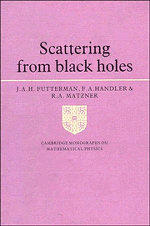Book contents
- Frontmatter
- Contents
- Acknowledgements
- Foreword
- 1 Introduction
- 2 Perturbations of black hole spacetimes
- 3 Integral spin plane waves in black hole spacetimes
- 4 Neutrino plane waves
- 5 Scattering
- 6 Limiting cross sections
- 7 Computation of cross sections
- 8 Absorption, phase shifts and cross sections for gravitational waves
- 9 Conclusion
- Appendix A1 Integrals used to express plane waves in terms of spin-weighted spheroidal functions
- Appendix A2 Addition formulae for spin-weighted spherical angular functions
- Appendix B
- References
- Index
8 - Absorption, phase shifts and cross sections for gravitational waves
Published online by Cambridge University Press: 04 August 2010
- Frontmatter
- Contents
- Acknowledgements
- Foreword
- 1 Introduction
- 2 Perturbations of black hole spacetimes
- 3 Integral spin plane waves in black hole spacetimes
- 4 Neutrino plane waves
- 5 Scattering
- 6 Limiting cross sections
- 7 Computation of cross sections
- 8 Absorption, phase shifts and cross sections for gravitational waves
- 9 Conclusion
- Appendix A1 Integrals used to express plane waves in terms of spin-weighted spheroidal functions
- Appendix A2 Addition formulae for spin-weighted spherical angular functions
- Appendix B
- References
- Index
Summary
Introduction
We now examine the details seen in the calculated quantities. Our aim is to supply a physically intuitive context in which to understand the scattering phenomenon as a whole. To that end we first discuss two simplified physically analogous problems, a square barrier and the null torpedo model. Most of the features of the calculated cross sections may be understood in terms of these simplified models.
We discuss in turn the calculated absorption of the incident wave as a function of l, the phase shifts as a function of l and the summed angular cross sections. The absorption as a function of l provides us with a measure of the apparent size of the hole as measured by the marginally trapped null trajectories for each incident mode. Further, by excluding the absorbed modes from the scattering cross section, we find we may anticipate certain features in the cross sections. The l modes which are not absorbed are summed in the angular cross section but contribute with their respective phase shifts. By examining the phase shifts we may understand the features of the angular cross sections in terms of interference of the l modes, governed by their phases. Finally, using physical intuition, we examine the detailed angular cross sections and find several interesting interference phenomena. These phenomena are analogous to similar phenomena seen in numerous classical and quantum scattering processes, in particular the glory phenomena described in section 6. Most of our results are for the scattering of gravitational radiation. However, we also include for comparison some very interesting results on the scattering of scalar waves in the Schwarzschild background, due to Sanchez (1978a, b).
- Type
- Chapter
- Information
- Scattering from Black Holes , pp. 136 - 166Publisher: Cambridge University PressPrint publication year: 1988



